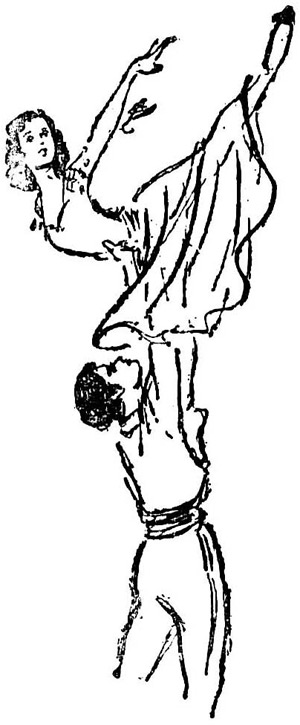|
 |
|
Jacinta and her sweetheart (Li Ke-yu) |
Peking watched with great interest the spirited performance of a four-act ballet by dancers who, before tackling this production, had previously had no regular, systematic ballet training. Daughter of Castile, presented by the Tientsin People's Song and Dance Company, played to packed houses throughout its two-week season which opened January 14.
This ballet was adapted by the noted Soviet composer R. Glier from the great Spanish dramatist and poet Lope de Vega's Fuenteovejuna (Sheep's Well). It tells the story, dating back to 1476, of the brave peasant girl Laurencia who led the people of her village to defy and destroy their oppressor, the local feudal lord.
The curtain rises on a Spanish country scene. A medieval castle and cathedral dominate the distance beyond the fields. The villagers of Sheep's Well, their day's work done, are on their way home carrying basketsful of grapes. Merrily they bid each other goodbye while the young people, lingering a moment, dance in light-hearted joy. From the very beginning the ballet shows its audience the gay, good nature and tough courage of the Spanish people.
Two young couples, Laurencia and Frondoso, Mengo and Jacinta, are in love. A dark shadow, however, overcasts their happiness. Fernan Gomez, the feudal lord, stands in their way. He tries to win the beautiful Laurencia but is angrily repulsed. In his frustrated lust, he ravishes young Jacinta. Jacinta, distraught, succeeds in escaping and returns home the night of Laurencia's wedding. Her suffering stirs the bitter wrath of the wedding guests. To overawe them, Gomez and his men kidnap the two young men. This only fans the flames of the popular anger and the villagers, led by Laurencia, storm and set fire to the castle to destroy the tyrant.
The critics have been warm in their praise and given a generally encouraging assessment of this bold effort on the part of the Tientsin company. In a matter of months, the dancers succeeded in learning some of the intricate techniques of classical ballet dancing. They delved into Spanish life and manners and have given pretty successful characterizations in the main roles. Tang Ying and Wang Pei-chuan, alternating in the role of Laurencia, present a brave, optimistic and lively heroine; Chu Hsueh-feng is a pure and tender Jacinta; Wang Kun is a warm and open-hearted Frondoso. They are well supported in the secondary roles and by the corps de ballet. |
